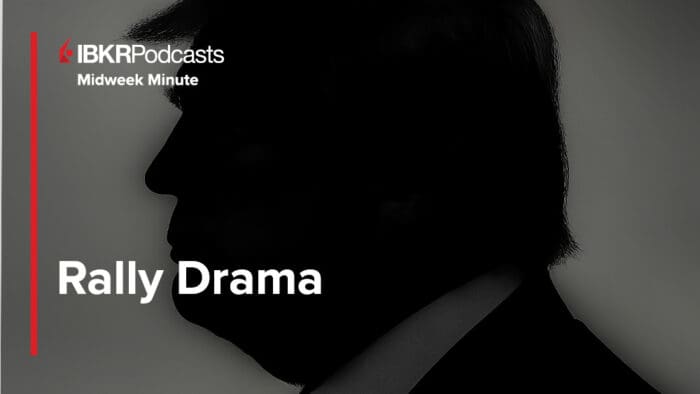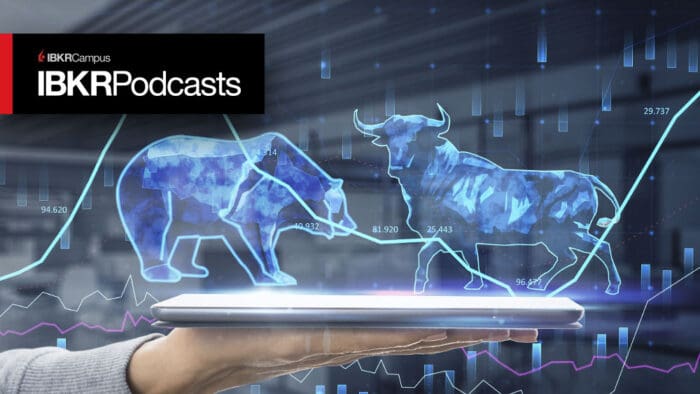Michael Normyle – Nasdaq’s US Economist joins IBKR’s Jeff Praissman to discuss the rise in bond yields and issuance.
Contact Information:
Email: Michael.Normyle@nasdaq.com
Web: www.nasdaq.com
Note: Any performance figures mentioned in this podcast are as of the date of recording (October 16, 2023).
Summary – IBKR Podcasts Ep. 111
The following is a summary of a live audio recording and may contain errors in spelling or grammar. Although IBKR has edited for clarity no material changes have been made.
Jeff Praissman
Hi everyone, welcome IBKR Podcasts. I’m your host, Jeff Praissman along with Andrew Wilkinson. In this podcast, we’re going to go over the rise in bond yields and issuance. It’s our pleasure to welcome back to the BKR podcast studio. Michael Normyle, Nasdaq US economist. Hey, Michael, how are you? Thank you for joining us.
Michael Normyle
Doing well, thanks for having me back.
Andrew Wilkinson
Hey, Mike can you describe to us the path of the 10-year Treasury yield during the Federal Reserve’s policy tightening? We’re recording today, October the 16th. So tell us, give us a sense of where yields are today as we go into the recording and the path. How are treasury yields relative to the short-term rate the Fed funds rate that the Fed sets at its policy meetings. And also could you address the 10 year breakeven inflation rate, why it’s significant and where we stand? There’s a lot to unpack there. I’ll hand it over to you.
Michael Normyle
Like you said, as of today, October 16th, 10 10-year Treasury yield, it’s about 4.7% right now and that’s up from about 4% a year ago, but that’s not too far below what the current Fed funds rate is. It’s in the 5.25 to 5.50 percent range right now, even though the Fed funds rate is a short-term overnight rate, whereas the 10-year rate, obviously, is a longer term 10-year rate. And so, the 10-year breakeven inflation rate, that signifies market expectations for average annual inflation over the next 10 years, and that’s derived from the difference between the nominal 10-year yield, the 4.7% that I mentioned earlier, and the real 10-year yield, which is also called the TIPS yield. And so right now the 10-year break even inflation rate is having around 2.3%. So that means markets expect annual inflation to average about 2.3% over the next 10 years.
Jeff Praissman
And Michael the 10-year Treasury yield that spiked up in September, there seems to be, you know, three main schools of thought on the significance and what it’s signaling. The first one being, you know, higher for a longer monetary policy or second one being higher growth expectations, third being higher term premium. Could you explain to our listeners each of those following three schools of thoughts?
Michael Normyle
Starting with higher for longer, that’s what the Fed’s been pushing for increasingly over Q3. So it’s even been going on before September, but by the start of Q3, that’s when it was clear that the acute phase of the banking crisis was contained so that wasn’t going to derail the Fed’s rate hike cycle. But if you recall back at the end of Q1 and when that was going on, there was some question about whether or not the Fed’s rate hike cycle would be derailed by the banking crisis. So then, over the course of Q3, the economy proved more resilient than many expected with the labor market and consumer spending both staying strong. So that means the Fed thinks that the economy is so strong that they have to keep rates, “higher for longer” to bring inflation back to 2%. And this was really hammered home at the September Fed meeting where they revised their rate projections from June. So they’re still planning one more rate hike this year. Markets are kind of split on whether or not that will actually happen, but the Fed’s still projecting it. But the big change was to next year where they now only plan to cut rates 50 basis points in 2024 to 5 to 5.25% compared to their June projection for 100 basis points in cuts and in response markets revised up their rate projections for the end of 2024, about 90 basis points to 4.8%. And then for the end of 2025, the Fed still sees rates as high as 3.75 to 4% and that’s well above their long run rate projection of 2.5%. So, all this means that the Fed projects that rates will be higher for longer, which impacts the longer end of the yield curve like 10-year yields.
So, for higher growth expectations, this is really the soft landing story essentially and again it’s something that’s been unfolding for a few months. So, if markets believe we’re going to have a soft landing, we’d have higher economic growth on average than if we had a recession. And then in a more robust economy investors might demand higher rates to tie up their capital since there are hypothetically many good uses for it and now reflected in real rates, which can be thought of as a proxy for expected economic growth. So you can see this by looking at the components of the 10-year Treasury yield, there’s the 10-year breakeven inflation rate that we discussed earlier and the real component, the 10-year TIPS yield. And since April the 10-year yield is up 140 basis points with 130 basis points of that coming from real rates while the inflation expectations have been essentially unchanged. So, it’s almost all real rates driving up the 10-year rates. So that’s really the kind of the expected higher economic growth over the next 10 years.
And the third point being the higher term premium. So, the term premium is the extra compensation an investor requires to buy longer duration assets. The problem is that this can’t be observed directly so we have to use estimates. The New York Fed estimate shows the 10-year term premium has risen 120 basis points since mid-July and even still it’s only barely positive at this point. But it’s really a measure of uncertainty, so the more uncertain you are about future rates or inflation or economic growth, the higher the term premium you’d require.
Andrew Wilkinson
Mike, if you’re a betting man, which of the three do you think explains most the spike in yields during September?
Michael Normyle
Well, I think I’m going to have to hedge a bit and say it’s really a bit of both looking at the timing, you know, it seems that the higher for longer rhetoric and the term premium both ratchet up more recently and if we even go a little bit farther back, it’s really probably all three that are playing a part here.
Jeff Praissman
So Michael, while the rates are higher, there’s also been an increase in treasury inventory being sold by the government. How is Wall Street reacting to this?
Michael Normyle
Well, so far, Treasury auctions have been orderly, so there’s not been any, you know, actual issue with the auctions but we’ve seen there’s been reports about Wall Street banks being concerned about the amount of treasuries being sold and the ability to absorb it all. And some of that has to do with reduced demand like from other sources like the Fed now that they’re doing quantitative tightening or QT. And then weaker foreign demand, so you know, Wall Street is concerned about having the ability to absorb that slack.
Andrew Wilkinson
And do you think the government will continue to issue debt at the rate it has been recently?
Michael Normyle
It does seem pretty likely, actually. So in Q2, the Treasury borrowed $660 billion. That increased to $1 trillion in Q3, and they’re planning on borrowing another $850 billion in Q4. And so, part of the reason we saw more borrowing in Q3 and Q4 has to do with the debt ceiling. So, when the economy hit the debt limit at the start of the year, the Treasury couldn’t issue more debt so it drew down its general account balance. But once the debt ceiling was suspended, they had to issue more debt than usual to build back up the buffer in the account. But JP Morgan actually estimates that we’ll see more issuance next year and as long as the government keeps running large deficits, they’re going to need to issue treasuries to fund that deficit. So really, we should expect to see pretty large amounts of issuance as long as there’s no real change to our budget outlook.
Jeff Praissman
What has been the effect of the increased issuance and yields on foreign investors?
Michael Normyle
Well we’ve seen a drop off in foreign demand, especially from Japan, which has been the US’s largest foreign creditor but this trend is actually it’s been going on for a few years now, and it has to do with interest rates rising around the world, not just in the US. So, you know, in Japan, where rates have been very low for a long time, their rates have started to go up and that increase in rates for Japanese bonds made them more attractive and the same goes for investors in other countries where domestic rates have increased as well. Plus, foreign investors avoid currency risk when they’re investing domestically.
Andrew Wilkinson
So Mike, this would be year 3 of losses in the bond market? That’s not normal, right?
Michael Normyle
It’s definitely not normal. If you look at the aggregate bond market, it’s actually never happened before going back almost 50 years.
Jeff Praissman
And with these higher rates and more treasuries issued, the US government is taking on more and more debt. What is the effect of this or what will be the effect of this if this trend continues?
Michael Normyle
Well, the trouble is that higher rates plus more debt equals more interest rate cost and the Congressional Budget Office projects the net interest as a share of GDP will increase from 2.5% now to 6.7.% by 2053 and this is another factor, something contributed to the increase in rates lately since a higher debt burden makes U.S. debt riskier and investors would require a higher yield to offset that risk. So, if the economy keeps running a deficit of 5% to 7% a year, which is what the CBO is projecting for the next decade, just imagine how big the deficit would get if we fall into a recession. So, really, it’s a question of debt sustainability. So, if you take Japan for example, where their debt to GDP ratio is over 250%, they’ve had to keep rates ultra-low for decades to keep that debt sustainable. So that’s you know, certainly a risk for the US too.
Andrew Wilkinson
Mike, any final thoughts that you’d like to leave the listeners with on this topic?
Michael Normyle
It will be interesting to see where things go from here, especially with the question of whether or not the Fed is done with rate hikes and when we see the first rate cut next year. So, we could be entering an interesting transition period in the next few months.
Andrew Wilkinson
What do you think the chances are of printing 5% of the 10-year before year end?
Michael Normyle
I’m not as … I guess I should say pessimistic about that, but yeah, I think there is of course a chance I might not have guessed it getting as high as almost 4.9% a week or two ago. So, there’s definitely definitely a chance, we’ll see but I would say maybe on the lower end of the scale.
Jeff Praissman
This is great, Michael, thank you. You know, once again, we want to thank Michael Normyle from Nasdaq for joining us at IBKR Podcasts. For more from Michael and Nasdaq, please go to our website under Education to view previous Nasdaq webinars as well as our previous podcasts. Also want to remind everyone that you can find all our podcasts on our website under Education, scroll down to IBKR Podcasts or on YouTube, Spotify, Apple Music, Amazon Music, Podbean, Google Podcasts and Audible. Thank you for listening, until next time, we’re Andrew Wilkinson and Jeff Prison with Interactive Brokers.
Disclosure: Interactive Brokers
The analysis in this material is provided for information only and is not and should not be construed as an offer to sell or the solicitation of an offer to buy any security. To the extent that this material discusses general market activity, industry or sector trends or other broad-based economic or political conditions, it should not be construed as research or investment advice. To the extent that it includes references to specific securities, commodities, currencies, or other instruments, those references do not constitute a recommendation by IBKR to buy, sell or hold such investments. This material does not and is not intended to take into account the particular financial conditions, investment objectives or requirements of individual customers. Before acting on this material, you should consider whether it is suitable for your particular circumstances and, as necessary, seek professional advice.
The views and opinions expressed herein are those of the author and do not necessarily reflect the views of Interactive Brokers, its affiliates, or its employees.















Join The Conversation
For specific platform feedback and suggestions, please submit it directly to our team using these instructions.
If you have an account-specific question or concern, please reach out to Client Services.
We encourage you to look through our FAQs before posting. Your question may already be covered!